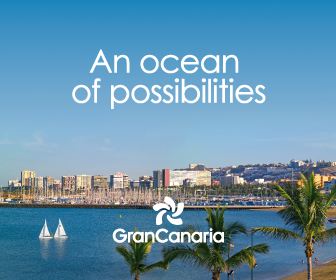Canary Islands: What to Know Before You Go
The Canary Islands are a popular stop for cruisers heading across the Atlantic. Regular Noonsite contributor Alison Gieschen and partner Dan, share information they wish they had known before setting sail to the islands to prepare for their own Atlantic crossing.
Published 12 months ago
“May the winds of adventure carry you to the Canary Islands, where each island is a chapter, and every wave whispers tales of timeless exploration.” Alison Gieschen
We spent two seasons sailing Portugal, Spain, and the Mediterranean. When it came to time to take the pilgrimage to the Canary Islands to prep for crossing the Atlantic to the Caribbean, we felt confident the passage would be a breeze. After all, several of our sailing buddies made the trip. While embarking on the seas of the unknown may be exhilarating and there’s a thrill in discovering a new destination, there are a few things I wish we had known before we set sail.

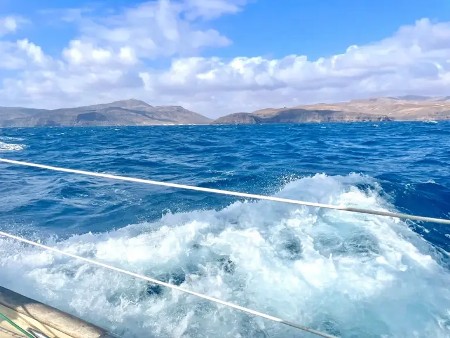
Don’t Trust the Weather Forecasts
If you’ve sailed long enough, you will have been bitten once or twice by the discrepancy between the weather reports and the actual sea conditions. This was never truer than on our passage from Puerto Sherry, Spain to head to the Canary Islands. The water pouring out of the Straits of Gibraltar collided with the Atlantic and we were caught in the maelstrom. Instead of two-meter waves, we had three-meter waves hitting us from behind and abeam. We were tossed around in the 20-plus knots of wind. It was the first time I got seasick since we began our voyage six years prior.
The morning of the third day of the five-day passage the wind and waves increased beyond the forecast as well. This is when we decided to take refuge in the port of Agadir in Morocco. We had an unexpected stop, but loved the chance to visit this part of the country. We were pleasantly surprised.
We waited patiently and made our jump across to the Canaries. The wind blowing from the Sahara was so good that we arrived 13 hours ahead of schedule. This meant anchoring in the dark when we arrived, but it was a heck of a sail!
Introduction to the Canary Islands
Sailing through the Canary Islands is an inevitable stop for blue water cruisers leaving Europe to cross the Atlantic. The Canaries, an archipelago off the northwest coast of Africa, consist of seven main islands, each contributing a unique character to this iconic staging area.
Tenerife, the largest, boasts the towering Teide volcano, while Gran Canaria’s diverse landscapes range from pristine beaches to mountainous terrains. Lanzarote’s Arrecife, known for its clear blue waters, is the closest port of entry. La Gomera, the second smallest island, boasts of being an integral part of the discovery of the Americas.

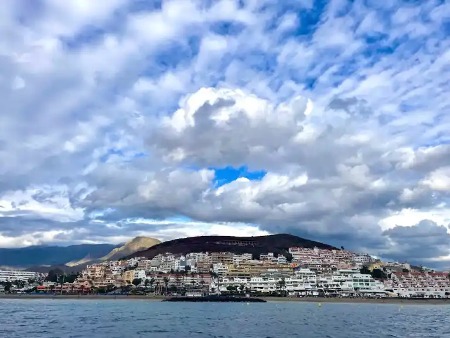
The remaining islands of Fuerteventura, La Palma, and El Hierro are also popular for their unique charm and landscapes. Several harbors in the Canary Islands are popular staging points for cruisers and sailing rallies preparing to cross the Atlantic. Here are some of the most well-known harbors in the Canaries:
- Las Palmas de Gran Canaria (Gran Canaria): Las Palmas, particularly the marina of Las Palmas de Gran Canaria, is a major hub for transatlantic sailors. It hosts the start of the annual Atlantic Rally for Cruisers (ARC), one of the largest transoceanic sailing events. It is a good harbor to find boat parts and get repairs.
- Puerto de la Luz (Gran Canaria): As a significant commercial port, Puerto de la Luz in Las Palmas also serves as a popular harbor for sailors preparing for transatlantic crossings.
- Marina Rubicón (Lanzarote): Located on the southern coast of Lanzarote, Marina Rubicón is a well-equipped marina with modern facilities and also a good harbor for repairs. It is a staging point for various transatlantic rallies.
- Marina Santa Cruz (Tenerife): Situated in the capital city of Tenerife, Marina Santa Cruz is a key harbor for sailors staging their journey across the Atlantic. Tenerife is often a preferred stop for cruisers before making the transatlantic leap.
- Puerto Calero (Lanzarote): Another notable harbor in Lanzarote, Puerto Calero, offers a relaxed atmosphere and comprehensive services. It is a popular harbor for sailors preparing for an ocean passage.
- Puerto Mogan (Gran Canaria): Often referred to as “Little Venice” for its charming canals, Puerto Mogan on Gran Canaria is a picturesque harbor attracting cruisers seeking a tranquil stopover before their Atlantic crossing.
- Puerto Rico (Gran Canaria): Positioned on the southwest coast of Gran Canaria, Puerto Rico offers a sheltered harbor and amenities for sailors looking to make final preparations.

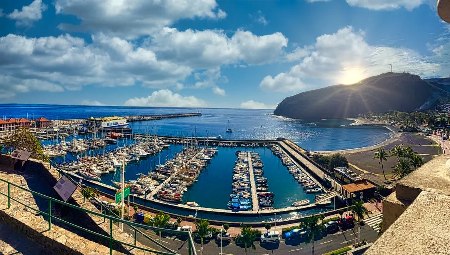
Delving into the Canary Islands’ history is fascinating. The Guanches, the islands’ original inhabitants, predate European exploration. Historically, the Canaries were notorious as home to the most pirates in the world, infusing these waters with tales of maritime conflicts. Each island has its own tail of sieges and battles until the unrest abated in 1479 when Spain finally took ownership.
Island Adventures
Once you anchor in a marina or drop your hook in crystal-clear waters if you have time, fascinating land adventures await.

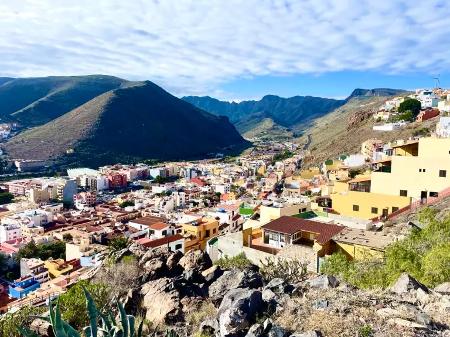
La Palma, with its UNESCO-listed biosphere reserve, invites exploration of ancient laurel forests. Tenerife’s Teide National Park offers a surreal moonscape around the towering Teide volcano.
Island-hop to La Gomera for its unique “whistling language,” and discover the volcanic landscapes of Lanzarote. If you are into history, you are going to want to spend a few days on each island.
The islands’ maritime history intertwines with the age of exploration. San Sebastián de La Gomera, the capital of La Gomera, played a pivotal role in the voyages of Christopher Columbus. It was from this port that Columbus set sail for all three of his epic journeys to the Americas.
It’s a pretty cool feeling to pull into the harbor with your own boat knowing this was the same port occupied by Columbus as he set off to explore the New World.
Challenges of Rally Season
Come November, the Canaries transform into a sailor’s haven and logistical puzzle. The World Cruising Club’s Atlantic Rally for Cruisers (ARC) organizes two rallies to the Caribbean each November/December with hundreds of participants in addition to smaller rallies like Viking Explorers with a couple of dozen boats departing in early January.

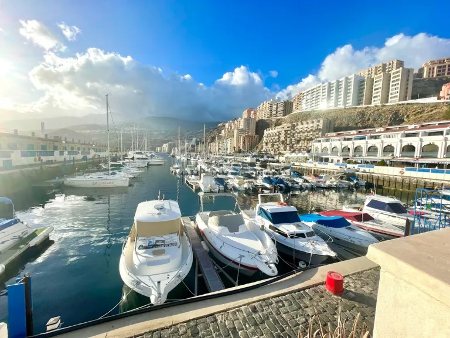
The result being large marinas like Las Palmas in Gran Canaria and Santa Cruz in Tenerife becoming very crowded and making berths a sought-after commodity throughout the islands. Navigating during rally season demands strategic planning and finding a suitable harbor becomes a competitive sport as marinas prioritize rally participants.
If you are looking for crew to cross the Atlantic, you will find an abundance of eager candidates in the major sailing ports. Hundreds of young hitchhikers from Europe stage themselves here offering their services as crew to get a ride to the Caribbean or South America. Be forewarned that while their bios may read well, not all of them have experience crossing oceans or even on boats in general. Yes, sometimes they are not truthful. We have heard several stories of bad experiences with taking on unknown crew members.
It is extremely encouraged to meet prospective crew beforehand. Taking them sailing for a few days before making a commitment to have them on board for an ocean crossing. Stories of captains getting to Cape Verde and kicking the crew off their boat before continuing across the Atlantic, are common as the crew did not live up to their expectations. You can advertise for crew members on the Facebook group Atlantic Crossing East to West.
Wind patterns and Sahara Dust
The Canary Islands are governed by trade winds, primarily the Northeast Trade Winds are influenced by the Azores High. The persistent winds create favorable sailing conditions. However, the occasional “calima” brings Sahara dust, affecting visibility and creating hazy conditions. Understanding wind directions is essential, as harbors are typically protected from specific wind directions.

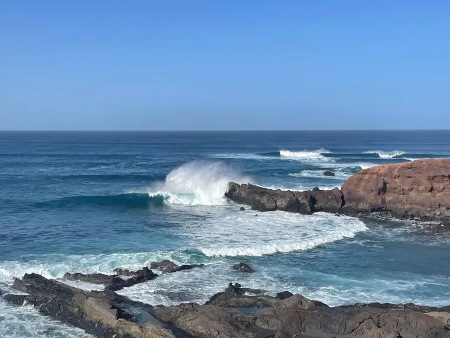
The harbors suitable for anchoring in the Canaries can be 20 to 40 miles apart. You need to plan carefully and watch the weather if you want to harbor hop and be safe from a poor wind direction for a particular harbor. You want to have backup plans if the wind changes or increases which may make some harbors extremely uncomfortable.
If you plan on stopping in at a marina, don’t expect a lot of communication. Most of them are slow to respond or may not respond at all for a berth request. Try to call or email them. Many of them are not available on the Navily app. However, if you don’t hear back from a marina, your best bet is to arrive and call them on the VHF or phone the office to find out if there is availability the day you arrive.
Most marinas are very friendly and will try to squeeze you into a spot, but have a backup plan just in case. If you can’t get a slip, you need to be able to find a safe harbor that same day. If the wind is not in your favor you may find yourself searching for an anchorage in rough conditions.
Sailing in the Canaries introduces you to dynamic seas, influenced by the region’s complex geological makeup. The islands’ positioning exposes them to swells from various directions. Expect choppy waters and large waves for most of your sailing time here.
Don’t rely heavily on the weather predictions as what they predict are often not what you get. Winds and seas can be radically different depending on which side of an island you are located. Acceleration zones are prevalent between these volcanic islands resulting in winds twice what is predicted outside the zone.
In summary
Your sailing experience in the Canary Islands can be enhanced with a little practical preparedness and with an appreciation for the layers of history that have shaped these waters. There are no other islands quite like the Canaries, the rugged volcanic landscapes merging with white beaches and palm trees.

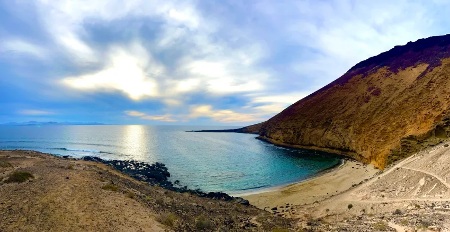
You will see a unique difference between each island. As you sail the complex waters around these islands, you may see whales, dolphins, and a plethora of beauty, but be wary of the wind and waves as the harbors don’t always provide refuge. Plan in advance, watch the weather, and be prepared for some challenging sails.
The Canaries offer a journey through time, connecting mariners to the explorers who once charted these seas. It’s an enriching experience for any sailor ready to navigate as long as you ‘Know Before You Go.’
Fair Winds,
Dan and Alison
S/V Equus
…………………………………….
About the Authors:
Alison Gieschen met her husband Dan in 1985 in a sailboat race in New Bern, North Carolina. After learning they both shared a passion to someday sail around the world, they fell in love, got married and raised a family. When the children were all grown up, Dan and Alison embarked on their sailing adventure, Their plans include visiting every continent and living aboard their sailboat for 10 years.
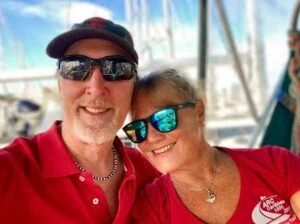
…………………………………….
Read Alison’s other articles on Noonsite:
- A Blueprint for Bluewater Sailing Relationships
- Starlink and Bluewater Cruising
- The Best Foods for Bluewater Sailing
- Encountering Nudity when Cruising.
- Five Blue Water Cruising Essentials for Sailing Comfort.
- Six Boat Items that Make Life Easier.
- Why Sailing Makes you Healthier.
Read more about their voyages:
Watch their videos:
Sailing Equus YouTube Channel.
…………………………………
The opinions expressed in this article are the author’s own and do not reflect the view of Noonsite.com or World Cruising.
…………………………………
Find out all news, reports, links and comments posted on Noonsite, plus cruising information from around the world, by subscribing to our FREE monthly newsletter. Go to https://www.noonsite.com/newsletter/.
Related to following destinations: Canary Islands, El Hierro, Fuerteventura, Gran Canaria, La Gomera, La Graciosa, La Palma, Lanzarote, Tenerife
Related to the following Cruising Resources: Atlantic Crossing, Circumnavigation, Routing






